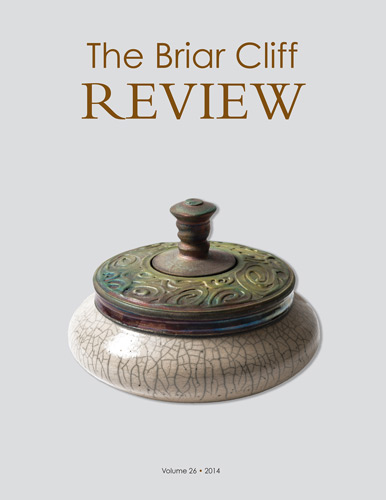The Briar Cliff Review – 2014
Great art has a distinctive voice, one that draws the reader into story, into a narrative or a lyric, into a situation or moment. For the duration, the reader lives under the influence of that voice and consequently feels a sadness at the finish, upon leaving. If the voice is strong, well-crafted, fine-tuned, easy to sink into, without artifice, aware only of its purpose and the story, the reader will be left satisfied. Great art has a distinctive voice, one that draws the reader into story, into a narrative or a lyric, into a situation or moment. For the duration, the reader lives under the influence of that voice and consequently feels a sadness at the finish, upon leaving. If the voice is strong, well-crafted, fine-tuned, easy to sink into, without artifice, aware only of its purpose and the story, the reader will be left satisfied.
In the 26th issue of The Briar Cliff Review, great literature and authoritative art reside. Each artist and writer makes a commitment to audience from the outset, so that they will want to continue because what is observed or read is authoritative and true. The editor, Tricia Currans-Sheehan, tells readers that stories originating from many different places can matter to readers in any place. She reminds readers what William Stafford wrote, “All events and experiences are local, somewhere.” The works in this issue are global and local and fulfill the covenant between artist and audience, providing fiction, nonfiction, artwork, and poems that matter.
Showcasing the importance of place are a number of works of art included in this issue. Structures and scenery are held in esteem in works such as “Red Door, Co. Galway, Ireland, 2012” by photographer Alyssa McCulloch, Jean Gaudaire-Thor’s stitched canvas “River in Summer,” and “Greenfield” oil on canvas by Judith Burton. These works transcend representation and encourage transformation and engagement.
The poetry in this issue hinges on place and atmosphere, the imagery that creates the space between the page and the reader. Elyse Schuler-Cruz’s “Four in the Morning — Joplin, Missouri” opens the scene in the first line: “It’s a mild night in Joplin” where “A half harvest moon hangs dingy gold / over flashing street lights / on a deserted stretch of road.” The language is evocative of the humid Midwest summer, the lights piercing the dark, the streets deserted. Finding the speaker in a bus station anchors meaning in someone there, but on his way; one who considers himself a refugee, belonging to no place. The moon also presides swinging in Jamie Sullivan’s “Iowa,” another Midwest vignette in which “Words peel from signs” and “Deer step like women from robes / onto the edges of the highway.” Even in these Midwest-leaning works is a global feeling in which Stafford’s words ring true and the local is anywhere in the world.
In particular contrast, “Call Me Tio,” the award-winning non-fiction piece by JL Schneider, informs how “Environment affects the body, and the body affects the mind, particularly the neocortex, the seat of culture.” Schneider demonstrates the distance between cultures in observation of a South American archeological dig and a bartending job, where he is both ethnographer and cultural anthropologist. The environment in this essay informs the behaviors and illuminates those in contrast to the surroundings, and in this case, the Americans come up wanting. Cultures out of their own element in an alien environment appear out of place.
This issue of The Briar Cliff Review is filled with so many stunning works of art and noteworthy works of fiction, nonfiction, and poetry that readers can immerse themselves in. The issue also includes an interview with author Jenna Blum and two book reviews. The contest winners included in the issue are not to be missed. Schneider’s essay is one, and the other two are “Thunder in Illinois,” a fiction piece by Leslie Kirk Campbell and “Apogee,” a poem by Rosa Lane. These pieces are rich with imagery and a sense of place that enlightens and makes the genuine visible. Spending time with the pages of this issue is an indulgence everyone can afford.
[www.bcreview.org]





